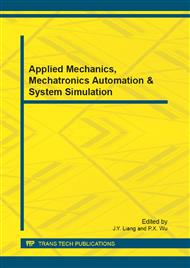p.1047
p.1053
p.1057
p.1062
p.1067
p.1073
p.1077
p.1083
p.1089
Research on the Battlefield Ferromagnetic Targets Recognition
Abstract:
In-depth analysis of the characteristics of the battlefield on the basis of ferromagnetic targets, according to the problems of magnetic fuse detection system, such as low detection resolution and poor status of target recognition, the new type of magnetic sensors based on Giant Magneto-Impedance(GMI) effect, because of the sensitivity, power consumption, etc. natural advantages, with its fuse detection system for the magnetic core components, combined with fuzzy neural networks, can guarantee that probe nano-Tesla(nT) accurately identify the target within the scope. Then, equable magnetization rotation elliptic is used to simulate the tank and military truck, taking the magnetic moments and semi-focal length, that are Mx, My, Mz and c, as recognition characteristic quantity, and the FNN is used to recognize the tank and military truck including the categories and motion directions. The method achieved good recognition results through experimental verification, and it has great significance to improve detection range and recognition accuracy.
Info:
Periodical:
Pages:
1067-1072
Citation:
Online since:
September 2012
Authors:
Price:
Сopyright:
© 2012 Trans Tech Publications Ltd. All Rights Reserved
Share:
Citation:


